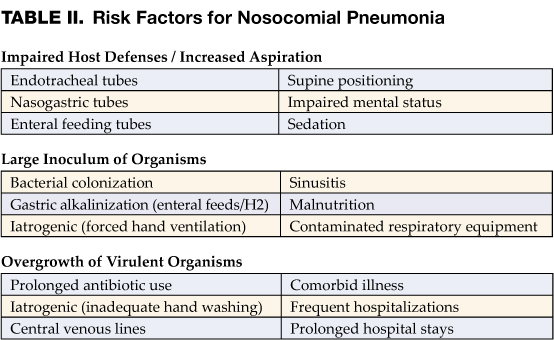The recommendations in this guideline represent the view of NICE arrived at after careful consideration of the evidence available. Bloodstream infections BSI pneumonia PNEU ventilator-associated infections VAE and surgical site infections SSI.
 Nosocomial Pneumonia The Hospitalist
Nosocomial Pneumonia The Hospitalist
The HAC Reduction Program encourages hospitals to improve patients safety and reduce the number of conditions people experience from their time in a hospital such as pressure sores and hip fractures after surgery.

Hospital acquired pneumonia definition. Sometimes it can be fatal. How we develop guidelines. The term Hospital-acquired Pneumonia or HAP has replaced HCAP.
Pneumonia Prevention Guidelines Print Version Cdc-pdf PDF 811 KB Page last reviewed. Hospital-Acquired Conditions Section 5001c of Deficit Reduction Act of 2005 requires the Secretary to identify conditions that are. Basics topic The following types of nosocomial pneumonia have been defined.
Pneumonia is a common nosocomial infection and remains the in-hospital acquired infection with the highest associated mortality. Hospital-acquired pneumonia HAP is one of the most frequent and most severe medical complications in patients which are hospitalized in intensive care units. Hospital-acquired pneumonia HAP or nosocomial pneumonia is a lower respiratory infection that was not incubating at the time of hospital admission and that.
Early-onset occurring within 4 days of admission HAP is usually caused by the. Frequency of hospital acquired pneumonia and its microbiological etiology in medical intensive care unit. The hospital acquired infection testing market report estimates the market size Revenue USD million - 2013 to 2020 for.
F Hospital-acquired pneumonia HAP is defined as pneumonia that occurs 48 hours or more after hospital admission and is not incubating at hospital admission. Likely pathogens differ from those causing community-acquired pneumonia and may require initial empiric antibiotic therapy that is active against antibiotic-resistant organisms. Centers for Disease Control and Prevention National Center for Emerging and Zoonotic Infectious Diseases NCEZID Division of Healthcare Quality Promotion DHQP.
As per the IDSA guidelines Hospital-acquired Pneumonia is defined as pneumonia that occurs 48 hours or more after admission to the hospital and did not appear to be incubating at the time of admission. NICE worked with Public Health England to develop this guidance. Hospital-Acquired Condition HAC Reduction Program What is the Hospital-Acquired Condition HAC Reduction Program.
Organisms belonging to the following genera cannot be used to meet any NHSN definition. Hospital-acquired pneumonia HAP is pneumonia that occurs 48 hours or more after admission and. A high cost or high volume or both b result in the assignment of a case to a DRG that has a higher payment when present as a secondary diagnosis and c could reasonably have been prevented through the.
Hospital-acquired pneumonia HAP is pneumonia that develops at least 48 hours after hospital admission in patients not receiving mechanical ventilation. Hospital-acquired pneumonia HAP is defined as pneumonia that occurs 48 h or more after admission which was not incubating at the time of admission. Hospital-acquired pneumonia is an infection of the lungs that occurs during a hospital stay.
People with hospital-acquired pneumonia their families and carers. For NHSN reporting purposes the term organisms in this chapter includes viruses. The Infectious Disease Society of America and American Thoracic Society IDSAATS guidelines define pneumonia as a new lung infiltrate plus clinical evidence that the infiltrate is of an infectious origin which includes new onset of fever purulent sputum leukocytosis and a decline in oxygenation.
Risk factors and prevention of hospital-acquired and ventilator-associated pneumonia in adultskeyword s of interest. November 5 2015 Content source. DEFINITION Hospitalacquired pneumonia HAP or nosocomial pneumonia NP has been defined 1 2 as pneumonia that develops 48h or more after admission to a hospital and does not include pneumonia that a patient had contracted when admitted or before being admitted.
This type of pneumonia can be very severe. Definition Hospital-acquired pneumonia HAP is an acute lower respiratory tract infection that is by definition acquired after at least 48 hours of admission to hospital and is not incubating at the time of admission.

/coughing-up-blood-possible-causes-2249394_final_CORRECTED-d935f4f656654c33a3371f83d0c7248c.png)


